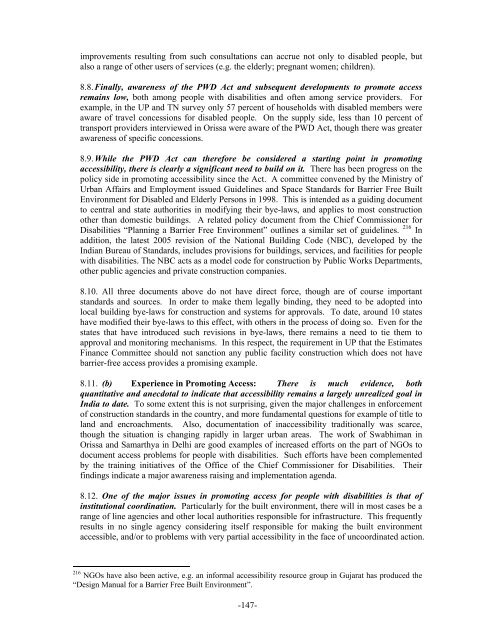People with Disabilities in India: From Commitment to Outcomes
People with Disabilities in India: From Commitment to Outcomes
People with Disabilities in India: From Commitment to Outcomes
You also want an ePaper? Increase the reach of your titles
YUMPU automatically turns print PDFs into web optimized ePapers that Google loves.
improvements result<strong>in</strong>g from such consultations can accrue not only <strong>to</strong> disabled people, but<br />
also a range of other users of services (e.g. the elderly; pregnant women; children).<br />
8.8. F<strong>in</strong>ally, awareness of the PWD Act and subsequent developments <strong>to</strong> promote access<br />
rema<strong>in</strong>s low, both among people <strong>with</strong> disabilities and often among service providers. For<br />
example, <strong>in</strong> the UP and TN survey only 57 percent of households <strong>with</strong> disabled members were<br />
aware of travel concessions for disabled people. On the supply side, less than 10 percent of<br />
transport providers <strong>in</strong>terviewed <strong>in</strong> Orissa were aware of the PWD Act, though there was greater<br />
awareness of specific concessions.<br />
8.9. While the PWD Act can therefore be considered a start<strong>in</strong>g po<strong>in</strong>t <strong>in</strong> promot<strong>in</strong>g<br />
accessibility, there is clearly a significant need <strong>to</strong> build on it. There has been progress on the<br />
policy side <strong>in</strong> promot<strong>in</strong>g accessibility s<strong>in</strong>ce the Act. A committee convened by the M<strong>in</strong>istry of<br />
Urban Affairs and Employment issued Guidel<strong>in</strong>es and Space Standards for Barrier Free Built<br />
Environment for Disabled and Elderly Persons <strong>in</strong> 1998. This is <strong>in</strong>tended as a guid<strong>in</strong>g document<br />
<strong>to</strong> central and state authorities <strong>in</strong> modify<strong>in</strong>g their bye-laws, and applies <strong>to</strong> most construction<br />
other than domestic build<strong>in</strong>gs. A related policy document from the Chief Commissioner for<br />
<strong>Disabilities</strong> “Plann<strong>in</strong>g a Barrier Free Environment” outl<strong>in</strong>es a similar set of guidel<strong>in</strong>es. 216 In<br />
addition, the latest 2005 revision of the National Build<strong>in</strong>g Code (NBC), developed by the<br />
<strong>India</strong>n Bureau of Standards, <strong>in</strong>cludes provisions for build<strong>in</strong>gs, services, and facilities for people<br />
<strong>with</strong> disabilities. The NBC acts as a model code for construction by Public Works Departments,<br />
other public agencies and private construction companies.<br />
8.10. All three documents above do not have direct force, though are of course important<br />
standards and sources. In order <strong>to</strong> make them legally b<strong>in</strong>d<strong>in</strong>g, they need <strong>to</strong> be adopted <strong>in</strong><strong>to</strong><br />
local build<strong>in</strong>g bye-laws for construction and systems for approvals. To date, around 10 states<br />
have modified their bye-laws <strong>to</strong> this effect, <strong>with</strong> others <strong>in</strong> the process of do<strong>in</strong>g so. Even for the<br />
states that have <strong>in</strong>troduced such revisions <strong>in</strong> bye-laws, there rema<strong>in</strong>s a need <strong>to</strong> tie them <strong>to</strong><br />
approval and moni<strong>to</strong>r<strong>in</strong>g mechanisms. In this respect, the requirement <strong>in</strong> UP that the Estimates<br />
F<strong>in</strong>ance Committee should not sanction any public facility construction which does not have<br />
barrier-free access provides a promis<strong>in</strong>g example.<br />
8.11. (b) Experience <strong>in</strong> Promot<strong>in</strong>g Access: There is much evidence, both<br />
quantitative and anecdotal <strong>to</strong> <strong>in</strong>dicate that accessibility rema<strong>in</strong>s a largely unrealized goal <strong>in</strong><br />
<strong>India</strong> <strong>to</strong> date. To some extent this is not surpris<strong>in</strong>g, given the major challenges <strong>in</strong> enforcement<br />
of construction standards <strong>in</strong> the country, and more fundamental questions for example of title <strong>to</strong><br />
land and encroachments. Also, documentation of <strong>in</strong>accessibility traditionally was scarce,<br />
though the situation is chang<strong>in</strong>g rapidly <strong>in</strong> larger urban areas. The work of Swabhiman <strong>in</strong><br />
Orissa and Samarthya <strong>in</strong> Delhi are good examples of <strong>in</strong>creased efforts on the part of NGOs <strong>to</strong><br />
document access problems for people <strong>with</strong> disabilities. Such efforts have been complemented<br />
by the tra<strong>in</strong><strong>in</strong>g <strong>in</strong>itiatives of the Office of the Chief Commissioner for <strong>Disabilities</strong>. Their<br />
f<strong>in</strong>d<strong>in</strong>gs <strong>in</strong>dicate a major awareness rais<strong>in</strong>g and implementation agenda.<br />
8.12. One of the major issues <strong>in</strong> promot<strong>in</strong>g access for people <strong>with</strong> disabilities is that of<br />
<strong>in</strong>stitutional coord<strong>in</strong>ation. Particularly for the built environment, there will <strong>in</strong> most cases be a<br />
range of l<strong>in</strong>e agencies and other local authorities responsible for <strong>in</strong>frastructure. This frequently<br />
results <strong>in</strong> no s<strong>in</strong>gle agency consider<strong>in</strong>g itself responsible for mak<strong>in</strong>g the built environment<br />
accessible, and/or <strong>to</strong> problems <strong>with</strong> very partial accessibility <strong>in</strong> the face of uncoord<strong>in</strong>ated action.<br />
216 NGOs have also been active, e.g. an <strong>in</strong>formal accessibility resource group <strong>in</strong> Gujarat has produced the<br />
“Design Manual for a Barrier Free Built Environment”.<br />
-147-










